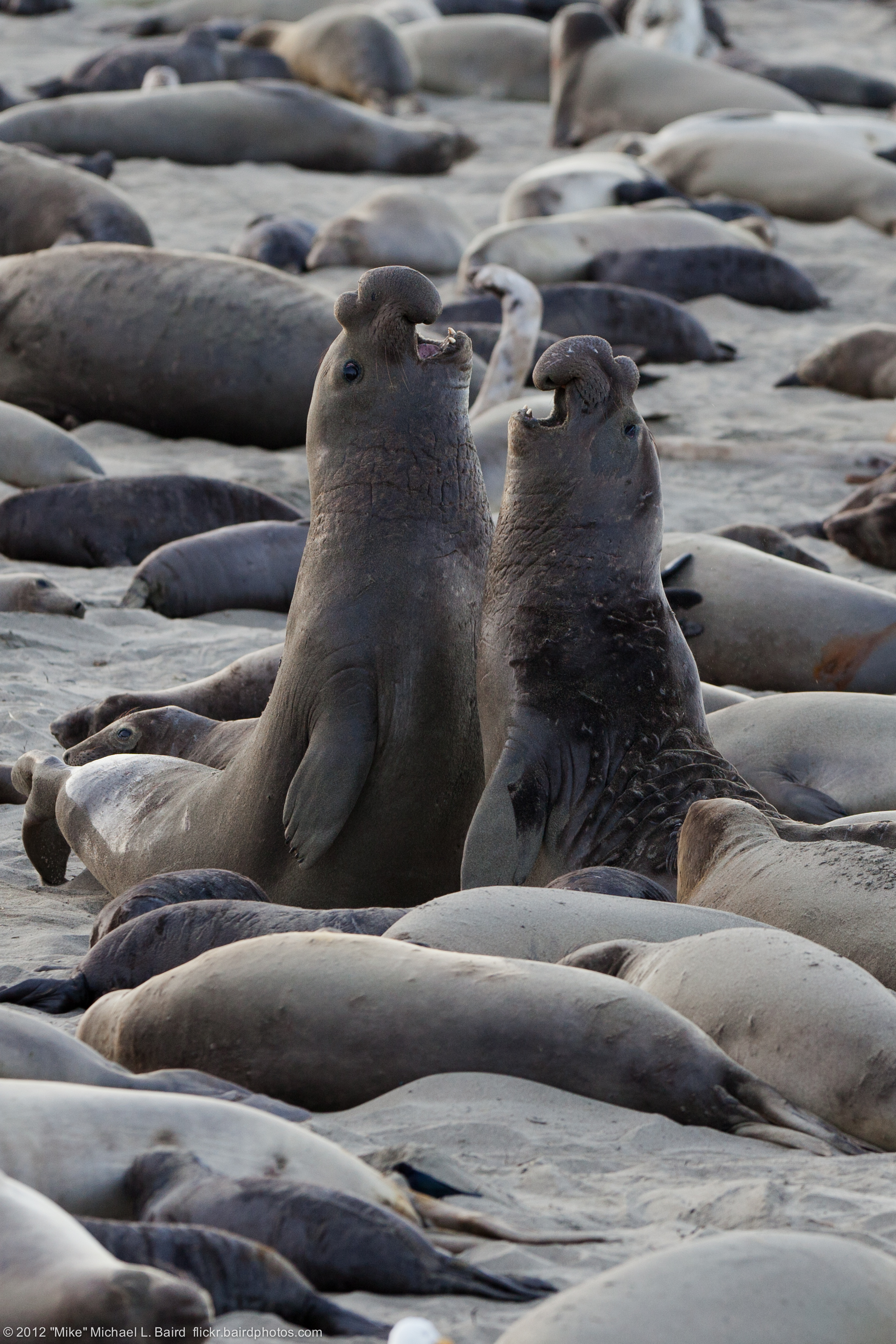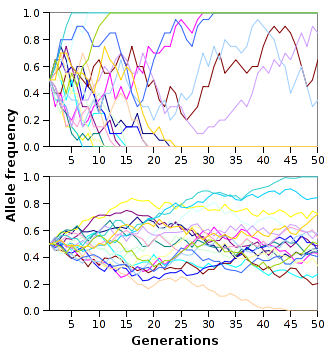Island Genetics on:
[Wikipedia]
[Google]
[Amazon]
Small populations can behave differently from larger populations. They are often the result of
 The influence of
The influence of  One demographic consequence of a small population size is the probability that all offspring in a generation are of the same sex, and where males and females are equally likely to be produced (see
One demographic consequence of a small population size is the probability that all offspring in a generation are of the same sex, and where males and females are equally likely to be produced (see
 Conservationists are often worried about a loss of
Conservationists are often worried about a loss of
population bottleneck
A population bottleneck or genetic bottleneck is a sharp reduction in the size of a population due to environmental events such as famines, earthquakes, floods, fires, disease, and droughts; or human activities such as genocide, speciocide, wid ...
s from larger populations, leading to loss of heterozygosity
In genetics, loss of heterozygosity (LOH) is a type of genetic abnormality in diploid organisms in which one copy of an entire gene and its surrounding chromosomal region are lost. Since diploid cells have two copies of their genes, one from each ...
and reduced genetic diversity
Genetic diversity is the total number of genetic characteristics in the genetic makeup of a species. It ranges widely, from the number of species to differences within species, and can be correlated to the span of survival for a species. It is d ...
and loss or fixation of allele
An allele is a variant of the sequence of nucleotides at a particular location, or Locus (genetics), locus, on a DNA molecule.
Alleles can differ at a single position through Single-nucleotide polymorphism, single nucleotide polymorphisms (SNP), ...
s and shifts in allele frequencies
Allele frequency, or gene frequency, is the relative frequency of an allele (variant of a gene) at a particular locus in a population, expressed as a fraction or percentage. Specifically, it is the fraction of all chromosomes in the population tha ...
. A small population is then more susceptible to demographic and genetic stochastic events, which can impact the long-term survival of the population. Therefore, small populations are often considered at risk of endangerment or extinction, and are often of conservation concern.
Demographic effects
 The influence of
The influence of stochastic Stochastic (; ) is the property of being well-described by a random probability distribution. ''Stochasticity'' and ''randomness'' are technically distinct concepts: the former refers to a modeling approach, while the latter describes phenomena; i ...
variation in demographic (reproductive and mortality) rates is much higher for small populations than large ones. Stochastic variation in demographic rates causes small populations to fluctuate randomly in size. This variation could be a result of unequal sex ratios, high variance in family size, inbreeding, or fluctuating population size.Frankham, R., Briscoe, D. A., & Ballou, J. D. (2002). ''Introduction to conservation genetics''. Cambridge university press. The smaller the population, the greater the probability that fluctuations will lead to extinction.
 One demographic consequence of a small population size is the probability that all offspring in a generation are of the same sex, and where males and females are equally likely to be produced (see
One demographic consequence of a small population size is the probability that all offspring in a generation are of the same sex, and where males and females are equally likely to be produced (see sex ratio
A sex ratio is the ratio of males to females in a population. As explained by Fisher's principle, for evolutionary reasons this is typically about 1:1 in species which reproduce sexually. However, many species deviate from an even sex ratio, ei ...
), is easy to calculate: it is given by (the chance of all animals being females is ; the same holds for all males, thus this result). This can be a problem in very small populations. In 1977, the last 18 kākāpō
The kākāpō (; : ; ''Strigops habroptilus''), sometimes known as the owl parrot or owl-faced parrot, is a species of large, nocturnal, ground-dwelling parrot of the superfamily Strigopoidea. It is endemic to New Zealand.
Kākāpō can be u ...
on a Fiordland
Fiordland (, "The Pit of Tattooing", and also translated as "the Shadowlands"), is a non-administrative geographical region of New Zealand in the south-western corner of the South Island, comprising the western third of Southland. Most of F ...
island in New Zealand
New Zealand () is an island country in the southwestern Pacific Ocean. It consists of two main landmasses—the North Island () and the South Island ()—and List of islands of New Zealand, over 600 smaller islands. It is the List of isla ...
were all male, though the probability of this would only be 0.0000076 if determined by chance (however, females are generally preyed upon more often than males and kakapo may be subject to sex allocation). With a population of just three individuals the probability of them all being the same sex is 0.25. Put another way, for every four species reduced to three individuals (or more precisely three individuals in the effective population), one will become extinct within one generation just because they are all the same sex. If the population remains at this size for several generations, such an event becomes almost inevitable.
Environmental effects
The environment can directly affect the survival of a small population. Some detrimental effects includestochastic Stochastic (; ) is the property of being well-described by a random probability distribution. ''Stochasticity'' and ''randomness'' are technically distinct concepts: the former refers to a modeling approach, while the latter describes phenomena; i ...
variation in the environment (year to year variation in rainfall, temperature), which can produce temporally correlated birth and death rates (i.e. 'good' years when birth rates are high and death rates are low and 'bad' years when birth rates are low and death rates are high) that lead to fluctuations in the population size. Again, smaller populations are more likely to become extinct due to these environmentally generated population fluctuations than the large populations.
The environment can also introduce beneficial traits to a small population that promote its persistence. In the small, fragmented populations of the acorn woodpecker, minimal immigration is sufficient for population persistence. Despite the potential genetic consequences of having a small population size, the acorn woodpecker is able to avoid extinction and the classification as an endangered species because of this environmental intervention causing neighboring populations to immigrate. Immigration promotes survival by increasing genetic diversity, which will be discussed in the next section as a harmful factor in small populations.
Genetic effects
 Conservationists are often worried about a loss of
Conservationists are often worried about a loss of genetic variation
Genetic variation is the difference in DNA among individuals or the differences between populations among the same species. The multiple sources of genetic variation include mutation and genetic recombination. Mutations are the ultimate sources ...
in small populations. There are two types of genetic variation that are important when dealing with small populations:
* The degree of homozygosity within individuals in a population; i.e. the proportion of an individual's loci that contain homozygous rather than heterozygous
Zygosity (the noun, zygote, is from the Greek "yoked," from "yoke") () is the degree to which both copies of a chromosome or gene have the same genetic sequence. In other words, it is the degree of similarity of the alleles in an organism.
Mos ...
allele
An allele is a variant of the sequence of nucleotides at a particular location, or Locus (genetics), locus, on a DNA molecule.
Alleles can differ at a single position through Single-nucleotide polymorphism, single nucleotide polymorphisms (SNP), ...
s. Many deleterious alleles are only harmful in the homozygous form.
* The degree of monomorphism/ polymorphism within a population; i.e. how many different alleles of the same gene exist in the gene pool of a population. Genetic drift
Genetic drift, also known as random genetic drift, allelic drift or the Wright effect, is the change in the Allele frequency, frequency of an existing gene variant (allele) in a population due to random chance.
Genetic drift may cause gene va ...
and the likelihood of inbreeding
Inbreeding is the production of offspring from the mating or breeding of individuals or organisms that are closely genetic distance, related genetically. By analogy, the term is used in human reproduction, but more commonly refers to the genet ...
tend to have greater impacts on small populations, which can lead to speciation
Speciation is the evolutionary process by which populations evolve to become distinct species. The biologist Orator F. Cook coined the term in 1906 for cladogenesis, the splitting of lineages, as opposed to anagenesis, phyletic evolution within ...
.Purdue University. "Captive breeding: Effect of small population size". www.purdue.edu/captivebreeding/effect-of-small-population-size/. Accessed 1 June 2017. Both drift and inbreeding cause a reduction in genetic diversity, which is associated with a reduced population growth rate, reduced adaptive potential to environmental changes, and increased risk of extinction. The effective population size
The effective population size (''N'e'') is the size of an idealised population that would experience the same rate of genetic drift as the real population. Idealised populations are those following simple one- locus models that comply with ass ...
(Ne), or the reproducing part of a population is often lower than the actual population size in small populations. The Ne of a population is closest in size to the generation that had the smallest Ne. This is because alleles lost in generations of low populations are not regained when the population size increases. For example, the Northern Elephant Seal was reduced to 20-30 individuals, but now there are 100,000 due to conservation efforts. However the effective population size is only 60.
Contributing genetic factors
*Genetic drift
Genetic drift, also known as random genetic drift, allelic drift or the Wright effect, is the change in the Allele frequency, frequency of an existing gene variant (allele) in a population due to random chance.
Genetic drift may cause gene va ...
: Genetic variation is determined by the joint action of natural selection
Natural selection is the differential survival and reproduction of individuals due to differences in phenotype. It is a key mechanism of evolution, the change in the Heredity, heritable traits characteristic of a population over generation ...
and genetic drift (chance). In small populations, selection is less effective, and the relative importance of genetic drift is higher because deleterious
{{Short pages monitor